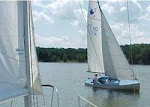 ing angle. To approximate the angle, project a line from a point 45% of the luff length above the tack, through the clew to deck.
ing angle. To approximate the angle, project a line from a point 45% of the luff length above the tack, through the clew to deck.This point on deck is where your jib fairlead should be.

FOR GOOD UPWIND PERFORMANCE tell tales on the jib luff are invaluable. Get some light knitting wool in a dark red, brown or black and using a needle poke it through your jib in the positions shown. Knot it close to the sail on each side so it can't pull out. Each side should project about 4 1/2 inches.
We can't see the wind on our sail but the tell tales tell us what the wind is doing!
When beating to windward, we want our jib to luff evenly from head to foot at the same time. Go out in a good breeze and bring the jib into the wind. All three windward tell tales should flutter at the same time. If they don't, move your jib sheet lead a little forward or aft until they do. When all flutter at the same time, your sheet lead is at the optimum position. MARK THAT POSITION. Your sheeting angle is now optimal for windward sailing.
When sailing to windward, keep your eyes on the jib tell tales. When both windward and leeward tell tales stream aft, you are achieving close to optimum jib performance. [diagram a]
If the windward tell tale flutters, you are close to luffing and must bear off a little. [diagram b]
If the leeward tell tale flutters, you are stalling the jib and must head up a little. [diagram c]

diagram a- Optimum jib performance -Leeward and windward tell tales stream aft.

diagram b- Windward tell tales flutter [up or down]- Sailing too close to wind- bear off or sheet in.

diagram c - Leeward tell tales flutter [up or down] - Jib is stalled - head up or ease off sheet.
GOOD SAILING!!

No comments:
Post a Comment